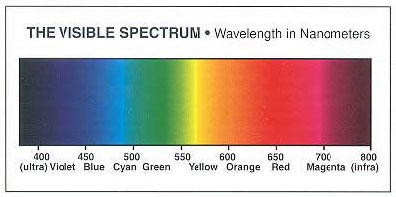II. Properties and Concepts of Light and Color
Thorough knowledge of the physical nature of light and light perception provides the foundation for a comprehensive understanding of optical measurement techniques. Yet, from a practical point of view there is little necessity to fully understand formation and propagation of light as an electromagnetic wave as long as the reader accepts wavelength as the most important parameter describing the quality of light. The human eye perceives light with different wavelengths as different colors (figure II.1.), as long as the variation of wavelength is limited to the range between 400 nm and 800 nm (1 nm = 1 nanometer = 10-9 m). In the optical range of the electromagnetic spectrum, wavelength is sometimes also given in Ångstrøm (Å= 10-10 m). Outside this range, our eye is insensitive to electromagnetic radiation and thus we have no perception of ultraviolet (UV, below 400 nm) and infrared (IR, above 800 nm) radiation.

Fig. II.1. Monochromatic electromagnetic radiation of different wavelengths between 400 nm and 800 nm causes the impression of different colors. Outside this wavelength range, the human eye is insensitive.
Download our Tutorials On Light Measurement. Size: 3 MB

Practical Solutions To Real Light Measurement Problems
Here's The Problem:
Your company manufactures a wide range of solid state lighting for various applications. You need to convince your customers that retrofitting their traditional site lighting with your new LED based lighting is a better way to go. But when comparing the light sources your filter based luxmeter is not doing a good job providing the light intensity and color temperature data you need to prove your claims. Also different customers are requesting different measurement quantities based on the lighting application, whether display, general, horticultural or other.
Here Are The Requirements:
- Fast accurate color, illuminance and color temperature information
- Able to measure all of the different measurands present in various lighting apps
- PAR measurement capability for horticultural applications
- TM 30-15 and CRI measurement capability for display lighting
- Multiple meters are required for sales reps and installation & service techs, requiring a cost effective solution
Here's The Solution:
Gigahertz-Optik's handy MSC15 spectral light meter. It's light & color measurement made simple.
Interested in discussing your light meter application?
Give us a call!

